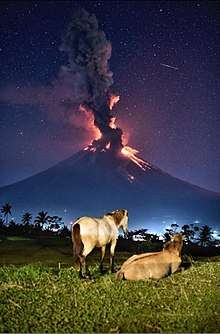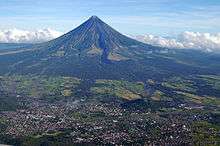Mayon
Mayon is an active volcano with a nearly perfect cone in the province of Albay in the Philippines. It forms the Mayon Volcano Natural Park, then named Mayon Volcano National Park, one of the first national parks of the country.
Understand
At a height of 2,465 m (8,087 ft), Mayon Volcano (Bulkang Mayon), also known as Mount Mayon, is a prominent natural landmark of Bicol region and Albay province. It is a composite volcano with a nearly perfect cone, and towers around the cities of Legazpi, Tabaco and Ligao, and the towns of Daraga, Guinobatan, Camalig, Bacacay, Santo Domingo, and Malilipot.
Mayon is a sacred site to the Bicolano people, and is the home of the ancient deity Gugurang. It forms a belt of volcanoes that dot the Bicol peninsula.
Local legend states Mayon came out from the burial site of a beautiful lady named Daragang Magayon, which lends its name to the volcano and the town of Daraga.
The national park surrounding the volcano, Mayon Volcano Natural Park has been part of the Albay Biosphere Reserve, and is a candidate to the UNESCO World Heritage List.
History

Mayon is a very active volcano; it last erupted in 2018. Its first recorded eruption dates back to the 17th century.
Its deadliest eruption happened in 1814. The 1814 eruption destroyed the town of Cagsawa, killed over 1,400, and released ash which are believed to also contributed to the "Year without a Summer" in 1816, precipitated by the 1815 eruption of Mount Tambora in the Dutch East Indies (present Indonesia).
1999 to 2001 is marked by a spate of eruptive activity, with the 2000 and 2001 eruptions causing damage to villages and agricultural land. The 2006 eruption is destructive and the second deadliest for Mayon. The eruption happened when a passing typhoon, named Durian (or locally "Reming"), brought rain that turned lava flows into lahar, killing over 1,300 people; the exact number of deaths is rather debatable due to many being buried under the mud. There are memorial crosses placed around barangays devastated by the mudflows.
Landscape

Mayon's foothills are covered with rainforest and patches of dried-up lava, and gives way to barren landscape at the peak and crater.
Flora and fauna
Climate
- See also: Legazpi#Climate
Mayon's climate is tropical, with no dry season, and it rains at any time. It is colder and windier at the barren peak.
The best time to visit is between February and March, which has more tolerable temperatures and less rainfall, but the peak season rather falls at the rainier months of June and July.
Fees and permits
Get around
There are two trails, all from the eastern side of the volcano. Both are difficult, and unless you are fit or have prior trekking experience, should not be attempted.
- Lidong Trail - The traditional climbing route to Mayon, it starts at barangay Lidong, a village at the border of Legazpi and Santo Domingo. The trailhead is near a golf course, and there are three campsites.
- New Lidong Trail - A newer trail, it is a gentler climb, and takes more than 2 hours. There are only two camps, and involves crossing a river.